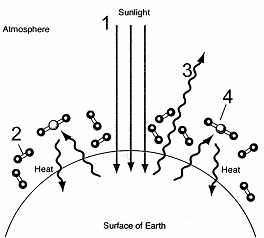The direct energy source that drives ATP synthesis during respiratory oxidative phosphorylation is
A) oxidation of glucose to CO2 and water.
B) the thermodynamically favorable flow of electrons from NADH to the mitochondrial electron transport carriers.
C) the final transfer of electrons to oxygen.
D) the difference in H+ concentrations on opposite sides of the inner mitochondrial membrane.
E) the thermodynamically favorable transfer of phosphate from glycolysis and the citric acid cycle intermediate molecules of ADP.
Ans: D) the difference in H+ concentrations on opposite sides of the inner mitochondrial membrane.
You might also like to view...
What is meant by the counterflow of fluid through the limbs of the loop of Henle, and what is its role in the normal
function of a human kidney? What will be an ideal response?
According to the accompanying figure, global warming would result from an increase in which of the labeled components?

a. 1 and 2
b. 2
c. 2 and 3
d. 3
e. 4
Which value(s) would be required to calculate how long ago the most recent ancestor of ungulates lived?
I) the number of base pairs that differ among species in a certain genetic sequence II) the total number of base pairs in the genetic sequence examined III) the age of a fossil ancestor for calibration A) I B) II C) III D) I, II, and III
A gastroenteritis which usually resolves in 72 hours is contracted from eating shellfish contaminated with
A) Campylobacter jejuni. B) Ehrlichia caffeensis. C) Helicobacter pylori. D) Vibrio cholera. E) Vibrio parahaemolyticus.